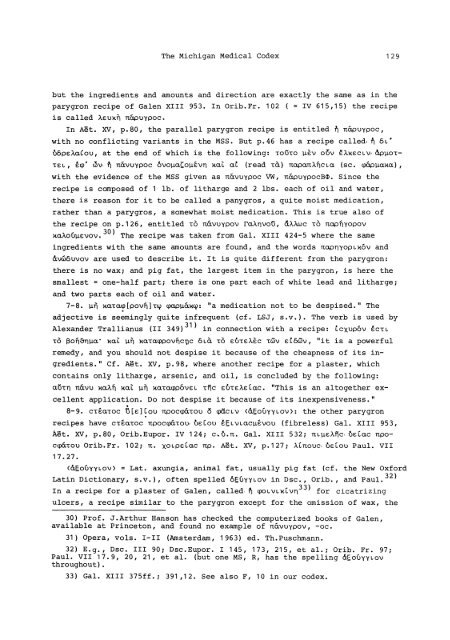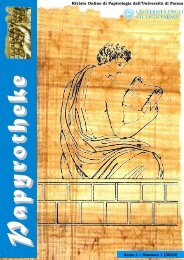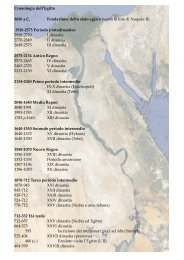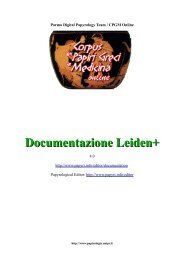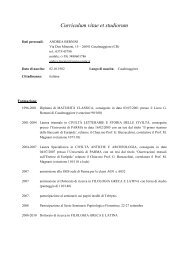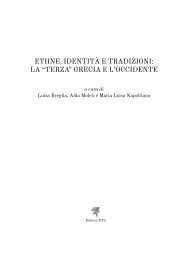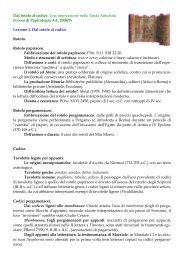The Michigan Medical Codex: P. Mich. Inv. 21 - Corso di Papirologia
The Michigan Medical Codex: P. Mich. Inv. 21 - Corso di Papirologia
The Michigan Medical Codex: P. Mich. Inv. 21 - Corso di Papirologia
Create successful ePaper yourself
Turn your PDF publications into a flip-book with our unique Google optimized e-Paper software.
<strong>The</strong> <strong><strong>Mich</strong>igan</strong> <strong>Me<strong>di</strong>cal</strong> <strong>Codex</strong> 129<br />
but the ingre<strong>di</strong>ents and amounts and <strong>di</strong>rection are exactly the same as in the<br />
parygron recipe of Galen XIII 953. In Orib.Fr. 102 ( = IV 615,15) the recipe<br />
is called Xeudn raLpuypoc.<br />
In Aet. XV, p.80, the parallel parygron recipe is entitled t ncpuypoc,<br />
with no conflicting variants in the MSS. But p.46 has a recipe called,h 6x'<br />
i5bpeXaXcou, at the end of which is the following: TOVTO Ev o6v 0 XVCCLV &p>LOT<br />
T6L,<br />
C@ ( vP 6 &avuypoc 6vo4aCo>e'n xai at (read Tla) TCpLPaTXTccxa (sc. 4paRa),<br />
with the evidence of the MSS given as nTavuypoc VW", r&puypocBB. Since the<br />
recipe is composed of 1 lb. of litharge and 2 lbs. each of oil and water,<br />
there is reason for it to be called a panygros, a quite moist me<strong>di</strong>cation,<br />
rather than a parygros, a somewhat moist me<strong>di</strong>cation. This is true also of<br />
the recipe on p.126, entitled TO navUypov r1ctRnvots, &X7xc To napTonyopoQv<br />
Raxou6ievov. 30) <strong>The</strong> recipe was taken from Gal. XIII 424-5 where the same<br />
ingre<strong>di</strong>ents with the same amounts are found, and the words nAoTL YOpLl{ov and<br />
&vw'6uvov are used to describe it. It is quite <strong>di</strong>fferent from the parygron:<br />
there is no wax; and pig fat, the largest item in the parygron, is here the<br />
smallest = one-half part; there is one part each of white lead and litharge;<br />
and two parts each of oil and water.<br />
7-8. vt Tas[pov]lTy qxapuat&y: "a me<strong>di</strong>cation not to be despised." <strong>The</strong><br />
adjective is seemingly quite infrequent (cf. LSJ, s.v.). <strong>The</strong> verb is used by<br />
Alexander Trallianus (II 349) 31) in connection with a recipe: LCxUpOv SCTL<br />
To faofinvt.a<br />
iax II' u povncic<br />
Lo. TIO 6TEXEC T5V 6%C75v,<br />
"it is a powerful<br />
remedy, and you should not despise it because of the cheapness of its in<br />
gre<strong>di</strong>ents." Cf. Aet. XV, p.98, where another recipe for a plaster, which<br />
contains only litharge, arsenic, and oil, is concluded by the following:<br />
aoTf nvVU ucaXf Rat v ITcLpOV6L p<br />
T nC Uc TSXacc. "This is an altogether ex<br />
cellent application. Do not despise it because of its inexpensiveness."<br />
8-9. clE'-oc *U[.?]iLOU TpocpaTou o (CPLV


